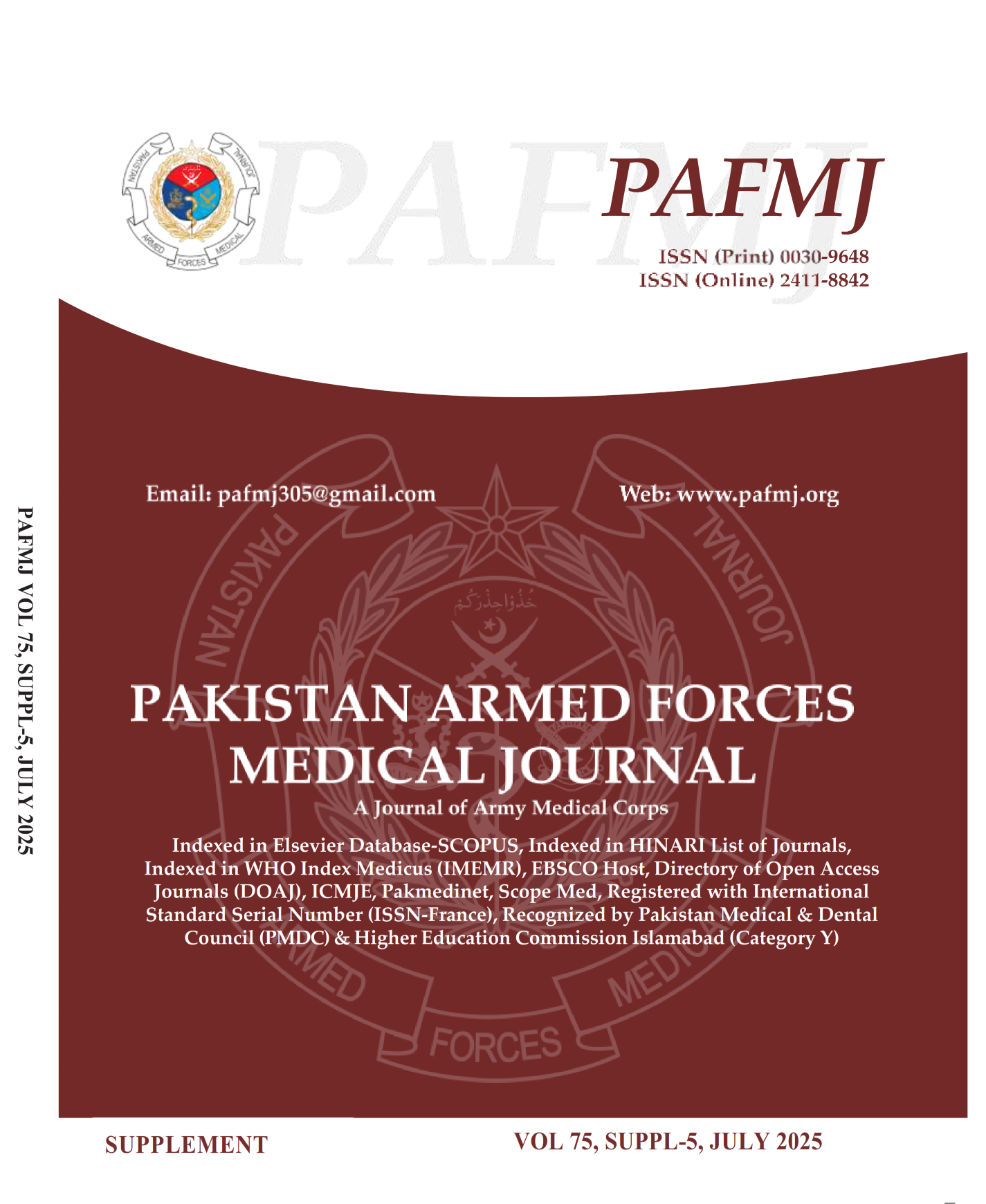COVID-19 Breakthrough Cases: A Descriptive Study from Pakistan Naval Hospitals
DOI:
https://doi.org/10.51253/pafmj.v75iSUPPL-5.7533Keywords:
COVID-19, COVID-19 Breakthrough Infection, Cansino, Sinopharm, Sinovac, Sputnik.Abstract
Objective: To measure the frequency of COVID-19 breakthrough infection in entitled vaccinated clientele of Pakistan Navy.
Study Design: Prospective longitudinal study
Place and Duration of Study: Naval Hospitals at Islamabad and Karachi Pakistan, from Mar to Aug 2021.
Methodology: Who received 04 types of vaccine including Sinopharm (n=18,246), Sinovac (n=10,716), Cansino (n=20,250) and
Sputnik vaccine (n=20,000). These individuals were monitored over time for development of COVID-19 infection. Vaccine
breakthrough case is defined as an individual who has SARS-CoV-2 RNA or antigen detected on a respiratory specimen
collected ≥14 days after completing the authorized SARS-CoV-2 vaccine. The data was collected by the record maintained in
hospital statistics office. The data was entered, stored and managed in the central data base as maintained at public health
department.
Results: Out of the total 69592 individuals who were inoculated 0.15% (i.e., n=111) cases developed COVID-19 breakthrough
infection. Cinopharm showed highest number of breakthrough cases 79(0.43%), Sinovac 19(0.17%), Cansino 07(0.034%) and
Sputnik 6(0.0003%). Age wise the highest recorded cases were belonging to less than 39 years followed by 37 cases among
individual aging 40 to 65 years, 08 cases in individuals age between 66 to 75 years and 10 cases were diagnosed in people
having more than 75 years of age.
Conclusion: Sinopharm vaccination was associated with highest frequency of breakthrough COVID-19 infection. While
Sputnik showed the least number of breakthrough COVID-19 infection cases.
Downloads
References
1. Labrague LJ, de Los Santos JAA. Fear of COVID-19, psychological distress, work satisfaction and turnover intention among frontline nurses. J Nurs Manag 2021; 29(3): 395-403.
https://doi.org/10.1111/jonm.13168
2. Khan, S. H. (2020). COVID-19, an infodemic associated with pandemic: The socioeconomic implications and pressure on healthcare. PAFMJ 70(2), 278-280.
https://pafmj.org/index.php/PAFMJ/article/view/4173
3. https://www.fda.gov/emergency preparedness-and-response/ coronavirus- disease-2019-covid-19/covid-19-vaccines Accessed date, July 2021.
4. Polack FP, Thomas SJ, Kitchin N, et al. Safety and efficacy of the BNT162b2 mRNA COVID-19 vaccine. N Eng J Med 2021; 383: 2603–2615.
5. Center for Disease Control and Prevention. Different COVID-19 vaccines, 2020. https://www.cdc.gov/coronavirus/2019-ncov/vaccines/different-vaccines.html
6. Wajnberg A, Amanat F, Firpo A, et al. SARS-CoV-2 infection induces robust, neutralizing antibody responses that are stable for at least three months. Science 2020; 370: 1227–1230.
7. Choe PG, Kim KH, Kang CK, et al. Antibody responses 8 months after asymptomatic or mild SARS-CoV-2 infection. Emerg Infect Dis 2020; 27.
8. Center for Disease Control and Prevention. SARS-CoV-2 variants. https://www.cdc.gov/coronavirus/2019-ncov/cases-updates/ variant surveillance/
9. Thangaraj JWV, Yadav P, Kumar CG, Shete A, Nyayanit DA, Rani DS, et al. Predominance of delta variant among the COVID-19 vaccinated and unvaccinated individuals, India, May 2021. J Infect 2021: S0163-4453(21): 00387-X.
https://doi.org/10.1016/j.jinf.2021.08.006
10. Mostafa HH, Luo CH, Morris CP, Li M, Swanson NJ, Amadi A, et al. SARS-CoV-2 Infections in mRNA Vaccinated Individuals are Biased for Viruses Encoding Spike E484K and Associated with Reduced Infectious Virus Loads that Correlate with Respiratory Antiviral IgG levels. medRxiv 2021: 7(5): 21259105.
https://doi.org/10.1101/2021.07.05.21259105
11. Ophinni Y, Hasibuan AS, Widhani A, Maria S, Koesnoe S, Yunihastuti E, et al. COVID-19 Vaccines: Current Status and Implication for Use in Indonesia. Acta Med Indones 2020; 52(4): 388-412.
12. Awadasseid A, Wu Y, Tanaka Y, Zhang W. Current advances in the development of SARS- CoV-2 vaccines. Int J Biol Sci 2021; 17(1): 8-19. 0
https://doi.org/10.7150/ijbs.52569
13. Ahamed F, Ganesan S, James A, Zaher WA. Understanding perception and acceptance of Sinopharm vaccine and vaccination against COVID-19 in the UAE. BMC Public Health 2021; 21(1): 1602.
https://doi.org/10.1186/s12889-021-11620-z
14. Pagliusi S, Jarrett S, Hayman B, Kreysa U, Prasad SD, Reers M, et al. Emerging manufacturers engagements in the COVID -19 vaccine research, development and supply. Vaccine 2020; 38(34): 5418-5423.
https://doi.org/10.1016/j.vaccine.2020.06.022
15. Saeed BQ, Al-Shahrabi R, Alhaj SS, Alkokhardi ZM, Adrees AO. Side Effects and Perceptions Following Sinopharm COVID-19 Vaccination. Int J Infect Dis 2021: S1201: 9712(21)00646-9.
https://doi.org/10.1016/j.ijid.2021.08.013
16. Jackson LA, Anderson EJ, Rouphael NG, Roberts PC, Makhene M, Coler RN, et al. An mRNA Vaccine against SARS-CoV-2 - Preliminary Report. N Engl J Med 2020; 383(20): 1920-1931.
https://doi.org/10.1056/NEJMoa2022483
17. Dai D, Wu X, Si F. Complexity analysis of cold chain transportation in a vaccine supply chain considering activity inspection and time-delay. Adv Differ Equ 2021; 2021(1): 39.
https://doi.org/10.1186/s13662-020-03173-z
18. Halstead SB, Katzelnick L. COVID-19 Vaccines: Should We Fear ADE? J Infect Dis 2020; 222(12): 1946-1950.
Downloads
Published
Issue
Section
License
Copyright (c) 2025 Chaudhry Muhammad Qamar Ul Haq Noor, Wasim Alamgir, Gul Naz Ahmad, Muhammad Aslam Channa, Muhammad Usman Rafique, Afaq Ahmed

This work is licensed under a Creative Commons Attribution-NonCommercial 4.0 International License.















